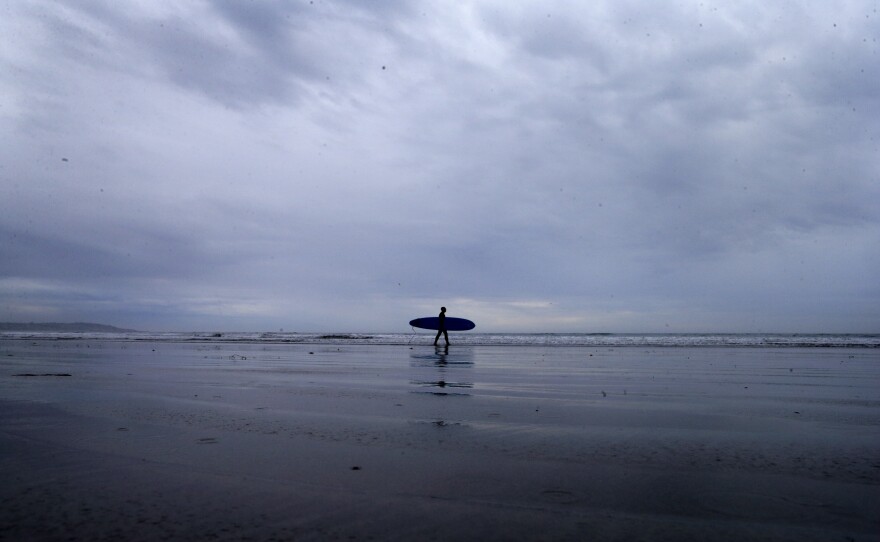A wool beanie is tugged snuggly over a shock of Taylor Moreheart’s wet hair on a cool morning at San Diego’s Tourmaline Surf Park, between Pacific Beach and La Jolla.
“The water level is definitely higher,” said the 23-year-old college student.
Short but regular waves are rolling in.
“This guy’s got a really good wave,” said Moreheart as she scanned the surf line. “Really, it’s kind of like looking at (the waves) and seeing who’s having the most fun and kind of like feeding off their energy.”
Southern California surfers like Moreheart might not know it. But their ability to know what the surf's going to look like is thanks to research done decades ago by legendary oceanographer Walter Munk, who died earlier this month.
It was Munk’s far-reaching work that cemented his title as the father of surf forecasting. Munk was instrumental in figuring out how waves moved over long distances and his work was the foundation that allows surf forecasting to shape local lives.
Moreheart started surfing at Tourmaline when she was seven. It was something she did off and on since then. Now she counts surfing as a passion.
“I think it’s really just the connection you feel with the ocean. The ocean controls my mood,” Moreheart said.
Even when the waves are not good, she still enjoys coming to the beach and communing with the environment and friends.
And she is not alone.
Times have changed
Lynn Sparks, 72, has been dipping his toes in the San Diego surf at Tourmaline for six decades. The fancy public bathrooms and easy-to-access parking lot were just a dream back then. Sparks remembered it being quite a chore to get to the water.
“We just carried the board, double-carried down the hill here. And we went in the water no matter how bad it was,” Sparks said.
Sparks could not see the ocean from his house so when he gathered his buddies to go down to the beach they did not know until they got there whether the waves would be any good.
There were no surfing forecasts.
“You just had to come down and check it out. Until you got a car you just went down and whatever there was there you went out and had fun with it, with all your friends,” Sparks said.
RELATED: Famed San Diego Researcher Walter Munk Welcomes 100th Birthday
Hitting the beach when the waves were rolling was a gamble.
“It was all quite hazy and no one knew when the waves were going to be good,” said Scott Bass, KPBS surf forecaster.
The promise of great waves shaped lives. Committed surfers allowed the uncertainty of the ocean to wash over their lives.
Bass knew a lot of people who chose jobs, schools, or even partners that were flexible enough to let them change plans at moment’s notice if good waves were crashing into the shore.
Science has changed that.
“We’re not so much at the beck and call, a hope and a prayer that we’re going to be there when it’s good. We can plan our lives a little bit better. Knowing that, hey, in three days the wind and the swell is going to be great. So you don’t have to worry for the next two days -- you get your responsibly taken care of,” Bass said.
Surf cameras now beam current conditions over the internet and forecasts have become much more sophisticated in large part because of work done decades ago by the late oceanographer Munk.

“Walter’s work was instrumental in figuring that out and that forms the basis of a lot of surf prediction that you see online today," said Dale Stokes, a researcher at the Marine Physical Laboratory at the Scripps Institution of Oceanography
"They’ve just sort of tweaked the calculations a little bit based on Walter’s original theories and that’s what we use to model surf — hitting the coast all around the world.”
Munk pioneered his surf forecasting models for the military. He famously predicted wave conditions on D-Day, clearing the way for the Allied invasion of German-occupied France.
In one famous experiment designed to understand the origin and movement of waves, Munk set up research stations from stormy Antarctica to Alaska.
“The energy from those very remote storm events does propagate across the ocean in a very measurable model-able pattern,” Stokes said.
That contribution to one of Southern California’s iconic pursuits will endure.
You can hear this story and other local news every morning by subscribing to San Diego Stories, KPBS’ daily news podcast. Subscribe via iTunes, Google Play or your favorite podcatcher.






